Neural Machine Translation in Linear Time
Author
- 저자:Nal Kalchbrenner, Lasse Espeholt, Karen Simonyan, Aaron van den Oord, Alex Graves, Koray Kavukcuoglu (Google Deepmind, London UK)
- 딥마인드 (
말 다했다)
Who is an Author?
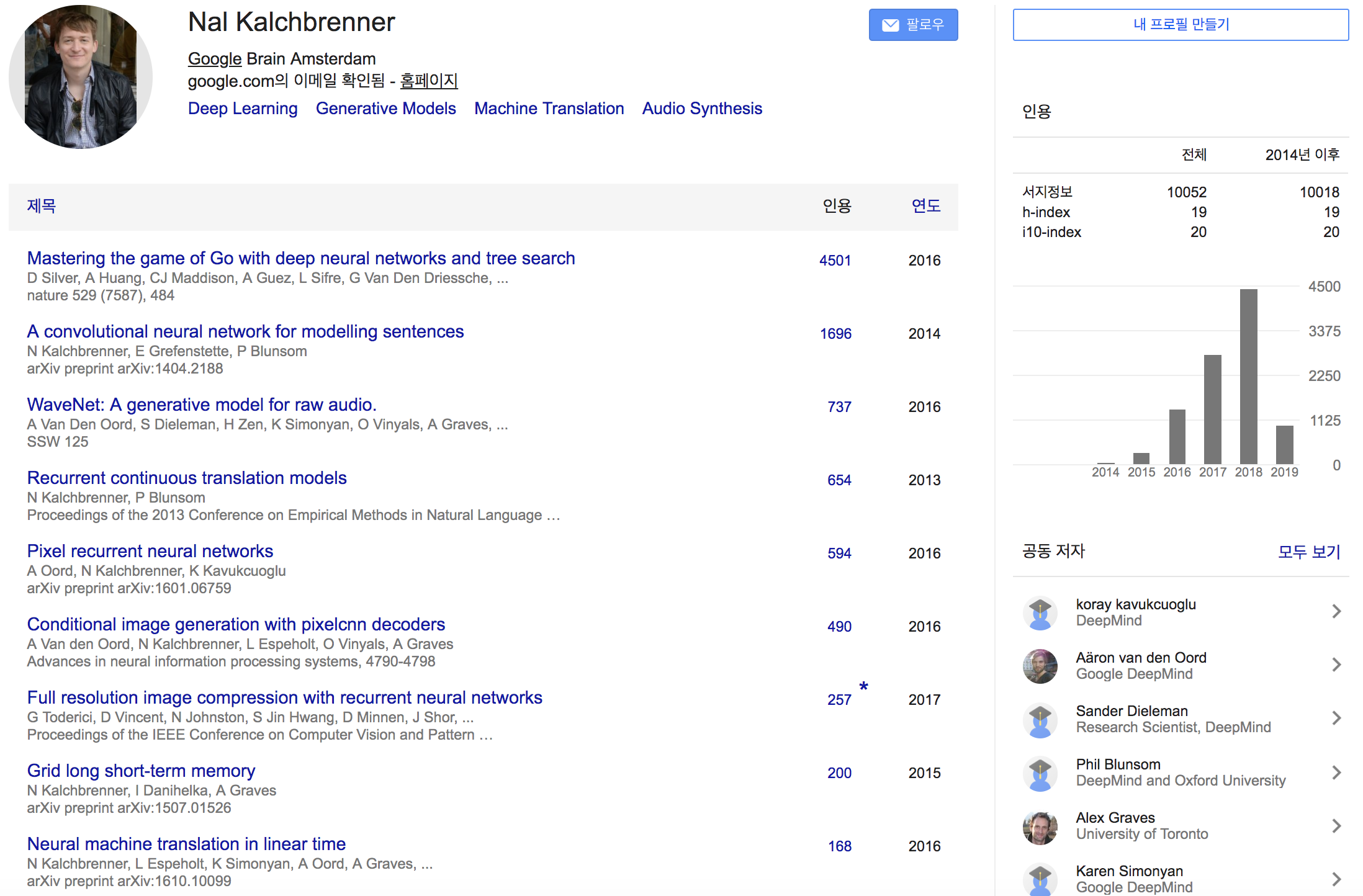 {: height=”50%” width=”50%”}
{: height=”50%” width=”50%”}
Abstract
- 이 당시엔 Novel architecture였다 (2016년, 후에
Attention is all you need논문에서도 인용함) ByteNet이라고 부름
 {: height=”50%” width=”50%”}
{: height=”50%” width=”50%”}
one-dimensional CNN이고 Encoder-Decoder구조인데 Decoder를 Encoder위에 Stacking한 구조임
- sequence의 temporal resolution 보존
- source와 target의 lengths가 다른 걸 잘 처리함
dilation방식(스케일을 넓힐 때 주로 사용함 자세한 내용은 아래 블로그 참고)의 CNN을 encoder(not masked), decoder(masked)에서 모두 사용함
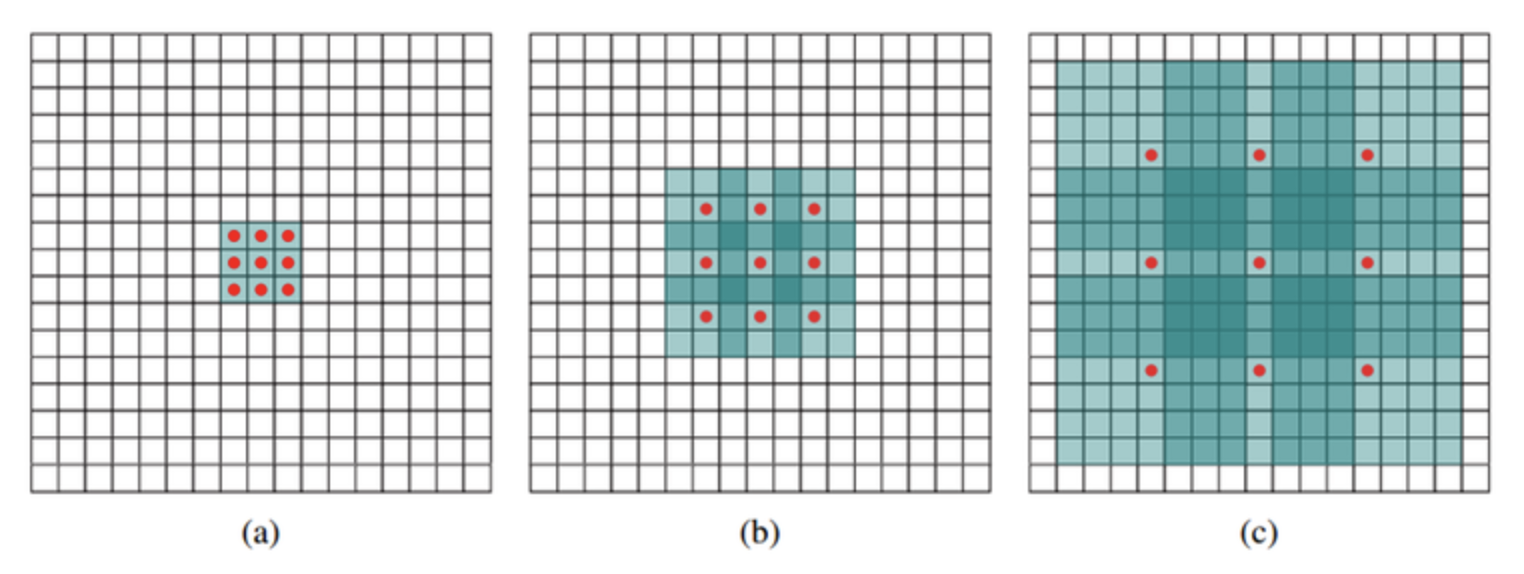 {: height=”50%” width=”50%”}
{: height=”50%” width=”50%”}Contribution
- sequence length에 linear한 runtime을 자랑함 (단점은 메모리가 좀 더 많이 필요함,
layer를 더 쌓아서 그런건가) - character-level LM에서 SOTA기록함 (이전 SOTA였던 RNN 프레임워크 성능 깸)
- character-to-character MT (English-to-German WMT translation task)에서도 SOTA기록함 (attenton게열의 quadratic run time 을 갖는 RNN 계열 프레임워크의 성능도 깸)
- 우리가 만든 representation이 토큰간의 latent alignment structure 정보를 갖고 있음을 알아냄
- sequence length에 linear한 runtime을 자랑함 (단점은 메모리가 좀 더 많이 필요함,
1. Introduction
- NMT에서 NeuralNet은 주어진 source lang의 시퀀스의 분포로부터 target lang의 시퀀스 분포를 estimate함
- Network는 크게 Encoder, Decoder 구조로 구성됨 (Kalchbrenner & Blunsom, 2013)
- RNN은 시퀀스 모델링에 파워풀하고 (Hochreiter & Schmidhuber, 1997), language modeling에 많이 사용되지만 (Mikolov et al., 2010) 잠재적 단점들이 있음
- RNN 구조상 parallel하게 실행이 안됨
- Forward & Backword 할때도 path의 full distance에 대한 조건이 요구됨 (전체 path를 다 봐야함)
- larger distance? -> dependency 배우기 어려워짐 (Hochreiter et al., 2001)
- 몇가지 네트워크가 계속 제안되었음
- encoder-decoder networks
- networks with attention pooling
- two dimensional networks
- 이런 모델들은 성능이 좋지만 running time이 sequence length에
super-linear하고 (실제로 이렇게 적혀있음, linear보다 기울기가 높은 함수를 말함) source sequence를 contant size의 representation으로 바꾸거나 무거운 memorization step을 사용한다든지 하는 단점이 있음 (sequence 길이가 증가할수록 심해짐)
- 제안 모델은 encoder-decoder 구조를 사용하면서 2가지 방법으로 위에서 말한 단점을 극복하고자함
- 첫번째는 encoder representation 위에 decoder를 쌓는 것임. 이렇게 하면 시퀀스의 temporal resolution이 보존됨(dependency 고려가 쉬워짐)
- fixex-size에 source sequence의 representation 저장하는 한계를 어느정도 극복할 수 있게됨 (Kalchbrenner & Blunsom, 2013; Sutskever et al., 2014)
- 두번째방법은
dynamic unfoldingmechanism을 사용하는 것임- source와 target의 길이가 다른 걸 간단하고 효율적으로 대응하게 해줌
- 첫번째는 encoder representation 위에 decoder를 쌓는 것임. 이렇게 하면 시퀀스의 temporal resolution이 보존됨(dependency 고려가 쉬워짐)
- ByteNet(제안모델)에서 사용하는 CNN은 fixed-dpeth형태의 one-dimensional CNN임
- The two CNNs (Encoder&Decoder) use
increasing factors of dilation to grow the receptive fields - Decoder에서 사용된 CNN은 target sequence에서의 future tokens을 보는걸 막기 위해
masking처리가 되어있음(transformer 아이디어와 비슷하네~ 본래의 이 아이디어는Pixel recurrent neural networks논문에서 먼저 사용됨, 본 논문의 저자가 2저자로 참여) (van den Oord et al., 2016b).
- The two CNNs (Encoder&Decoder) use
- 이 네트워크는 learning과 computational 관점에서 이점이 있음
- computational 관점에서는 source & target sequence 길이에 linear한 runtime을 가짐
- encoding 부분과 decoding부분을 training시에
parallel하게 돌릴 수 있음 (Sec2 참고)
- encoding 부분과 decoding부분을 training시에
- learning 관점에서는 source sequence의 representation이
resolution preserving됨- 단, 메모리는 더 필요함
- 덕분에 encoder-decoder 사이의 bandwidth도 최대가 됨
- computational 관점에서는 source & target sequence 길이에 linear한 runtime을 가짐
- 본 논문에서는 ByteNet을 character-level langauge modeling과 character-to-character machine translation에 적용함
- Hutter Prize Wikipedia task로 decoder network에 대해 평가함 (이 당시 SOTA는 1.31 bits/character임)
- English-to-German WMT benchmark로 평가함 (이 당시 SOTA는 BLEU score: 22.82(0.38 bits/character), 25.53(0.389 bits/character) on 2014, 2015 test sets)
- 그 당시 SOTA인 GNMT 모델 보다 더 나은 결과를 보여줌
2. Neural Translation Model
- NMT model은 다음의 분포를 estimate함
 {: height=”50%” width=”50%”}
{: height=”50%” width=”50%”}
- s: source toekns, t: target tokens
- 토큰은 단어가 될수도, 캐릭터가 될 수도 있음
- source network(encoder)와 targer network(decoder)로 source representation을 target string이 되게 만들 것임
- 문장을 만들어내는 거니까 당연히 decoder가 language model처럼 동작한다고 볼 수 있음
- NMT의 basic properties
- autoregressive: 자기 자신의 값을 사용함 (decoder)
- source와 target token의 order에 민감함
It is also useful for the model to be able to assign a non-zero probability to any string in the target language and retain an open vocabulary
- 보통의 NMT가 이러한 basic properties를 갖지만 본 논문에서의 모델은 이것 이외의 properties를 갖게 하고자함
- linear run time (parallel computing)
- size of source representation (fixed ->
in the length of the source string);resolution preserving, not constant size - 더 짧은 signal path (network 내의 forward, backward signal); 아마 층이 쌓일 수록 멀리 있는 것까지 고려해주는 계산 방식(dilation)이 있어서 그런듯
3. ByteNet
- [encoder] + [decoder stacked on an encoder]
- Generate
variable-length outputsviadynamic unfolding - masking은 decoder 부분에만 적용함
- decoder 부분엔 Residual block이 적용됨
3.1. Encoder-Decoder Stacking
- 제안하는 논문의 특징중 하나가 바로 Encoder와 Decoder를 연결하는 방법이 새롭다는 것 (이 당시 기준)
- To maximize
the representational bandwidthbetween the encoder and the decoder - fixed-size vector 또는 attentional pooling (Bahdanau et al., 2014 including 조경현교수님)과 같은 방법과는 대조된다고 말함
- 그렇지만 decoder가 encoder의 state까지 참조하는건 아님, encoder output의 representation까지만 참조함
- 단순히 참조하는 state가 한개가 아니라 여러개로 늘어났다는게 의의가 있을듯..
3.2. Dynamic Unfolding
- Encoder와 Decoder가 처리하는 sequence의 length가 다르다면 둘은 directly connected 될 수 없음
- 이를 해결하기 위해 Dynamic Unfolding이라는 메커니즘을 제안함
 {: height=”50%” width=”50%”}
{: height=”50%” width=”50%”} - 원리는 간단함.
encoder의 output의 representation이 적당한 길이|t^|(|s|에 linear relationship)를 갖도록 생성함; source sequence length|s|와 target sequence length|t|로적절하게(?)생성 - 대게
|t|보다는|t^|가 길게 나옴 (a=1.20, b=0으로 논문에서 설정함) 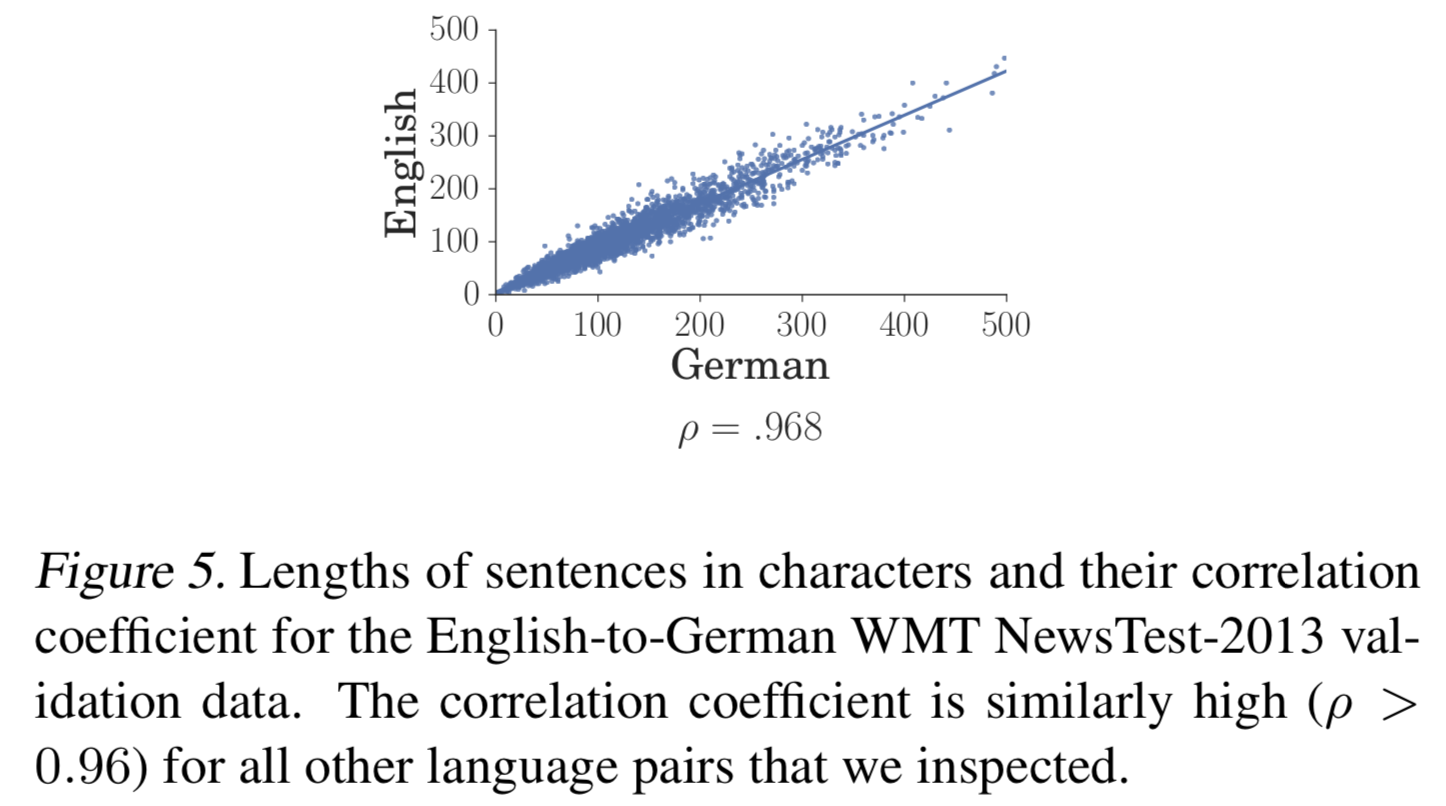 {: height=”50%” width=”50%”}
{: height=”50%” width=”50%”}- 이 적절한 길이의
encoder output representation으로 decoder에서 상황에 맞게(decoding되는 길이에 맞게) 가져다 쓰며 decoding함 {: height=”50%” width=”50%”}
{: height=”50%” width=”50%”} - EOS가 미리 나오면 그 time step까지만 쓰고,
|t^|보다 길게 나오면 encoder output representation 없이 EOS 나올때 까지 decoding 진행함 - source에 padding을 추가해서 생성함 (논문에 자세히는 안나옴)
3.3 Input Embedding Tensor
- target sequence에서 처음 n개만 우선 input으로 임베딩시킴
(0~n-1) (1~n)번까지 prediction을 위한 target으로 셋팅- input으로 임베딩된 텐서 + prediction으로 사용되는 tensor가 concat되면서 n x 2d 차원을 가짐 (d == number of inner channels in the network)
3.4 Masked One-dimensional Convolutions
- decoder에서는
Pixel Recurrent Neural Networks (DeepMind, 2016)에서 사용한masked one-dimensional convolution을maksed kernel size *k*로input embedding tensor에 대해서 적용함 - Masking은 future tokens에 대해서 적용함 (prediction시에 current token이 영향받지 않도록!, Loss 계산을 생각해보면 좋을듯)
- kernel weight를 zero로하거나 input map에 padding처리해서 구현함
3.5 Dilation
- masked convolution에 적용됨
- target network (decoder)의 receptvie field 크기 넓히려고 사용함
- Network depth 커질수록, Dilation을 통한 receptive field도 exponentially 커짐 (layer depth에 double로 증가, dilation rates r = 16으로 사용함, 1부터 시작해서 16까지 커짐)
3.6 Residual Blocks
- 각 레이어는 residual block으로 래핑됨
- residual block은 additional convolutional layer가 있고 filter size는 1 x 1 임
- 본 논문에서는 2가지 버전의 residual blocks을 사용함
- 하나는 ReLU(NMT에서 많이 씀)
- 나머지 하나는 Multiplicative Units(Language Modeling에서 많이씀)을 활성함수로 씀
- Multiplicative Units(MU)는 Video pixel Networks (Kalchbrenner et al., 2016b; 본인이 썼던 논문) 에서 가져온 개념임
- 두 버전 모두 다 활성함수 전에 Layer-Norm 사용함
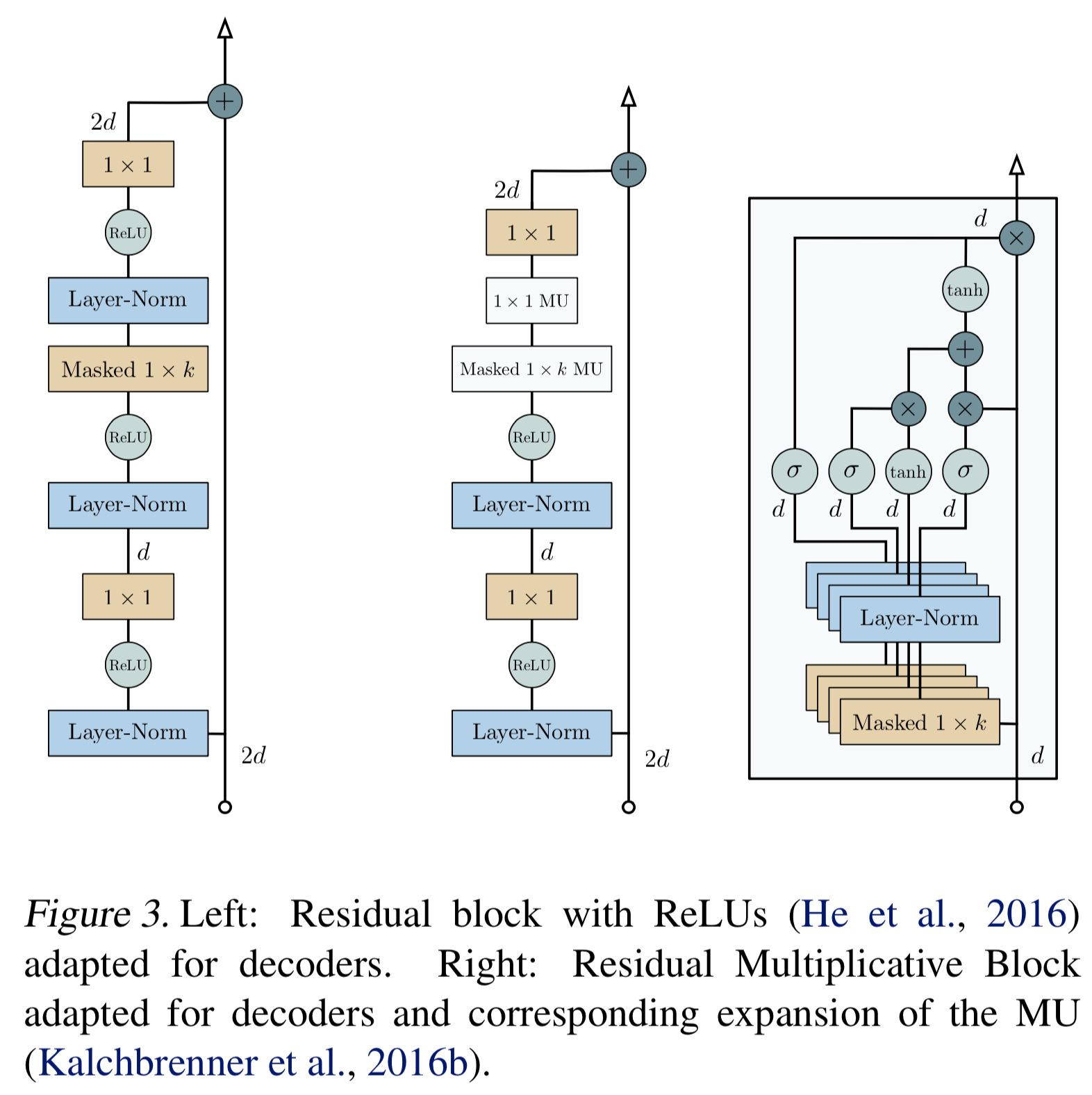 {: height=”50%” width=”50%”}
{: height=”50%” width=”50%”}
4 Model Comparison
4.1 Recurrent ByteNets
- 비교를 위해 Recurrent 버전까지 추가하겠음
- [1] Decoder를 RNN으로 바꿔보자
- [2] Enocder, Decoder 모두 RNN으로 바꾸되 stacked decoder 유지하자 (RNN Enc-Dec 구조와 가장 유사함)
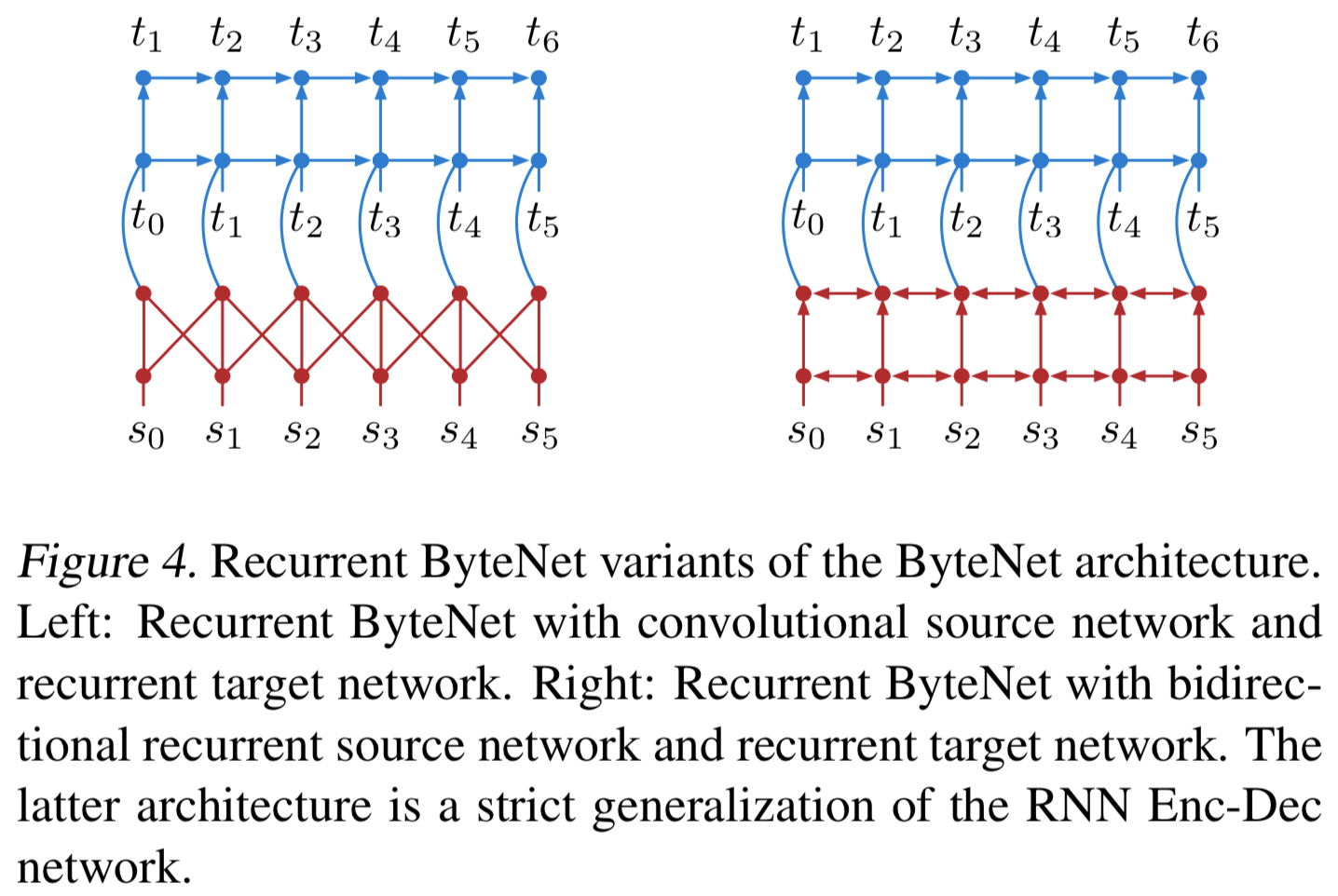 {: height=”50%” width=”50%”}
{: height=”50%” width=”50%”}
4.2 Comparison of Properties
- Runtime 비교
- 참고용어
- RCTM: Recurrent Continuous translation
- RP: Resol4ution Preserving
- Path_S: length from source token to any output target token
- Path_T: length from input target token to any output target token
- ByteNet이 linear runtime도 보존 되고, RP도 만족시킴
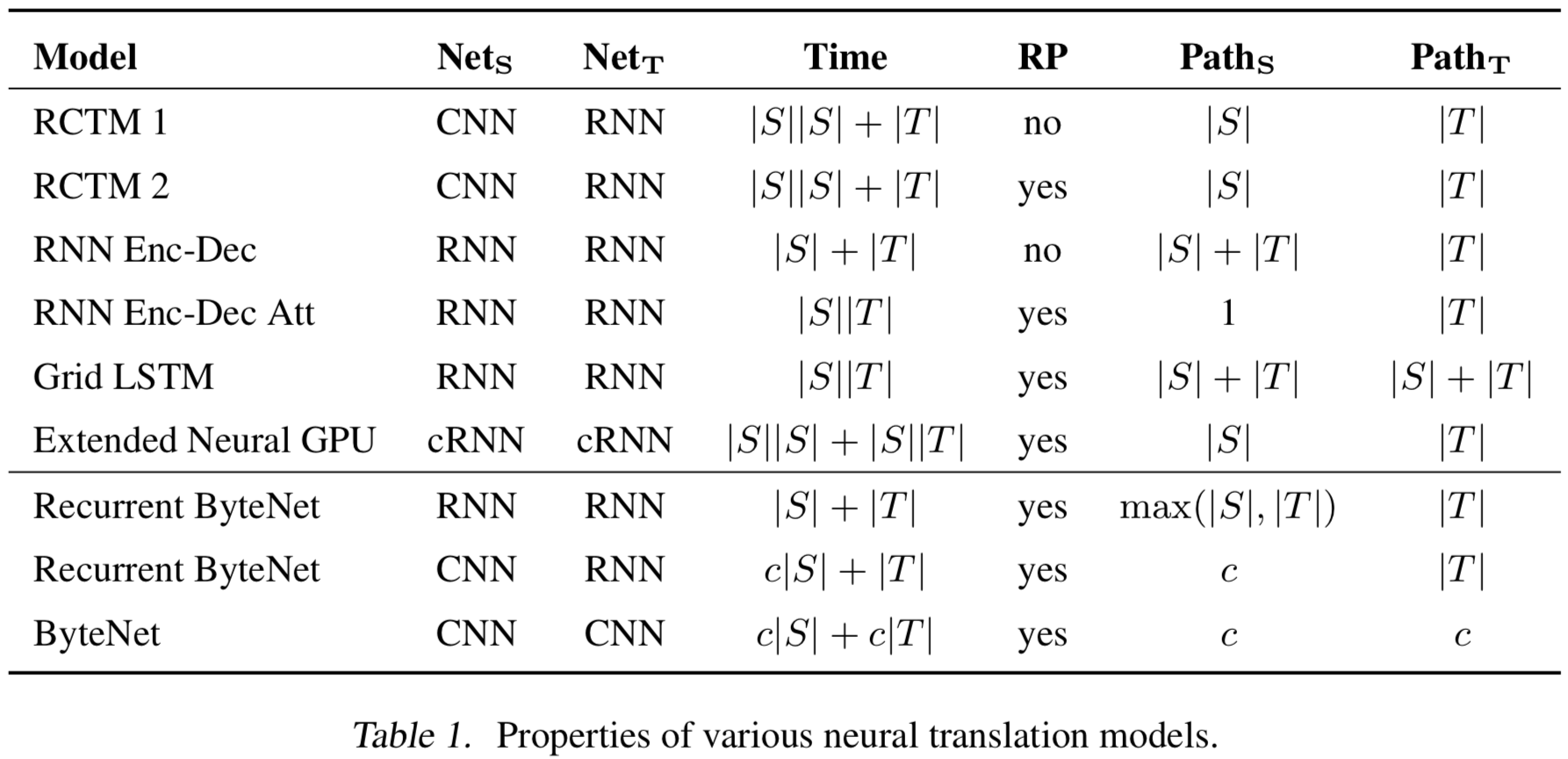 {: height=”50%” width=”50%”}
{: height=”50%” width=”50%”}
5. Character Prediction
- Character-level language modelling benchmark에 대해서 평가함
Hutter Prize version of the Wikipedia dataset사용- 90 million bytes: training
- 5 million bytes: validation
- 5 million bytes: testing
- ByteNet Decoder’s hyper params
- 30 residual Blocks: 6 sets * 5 blocks
- 5 blocks’s dillation rates: 1, 2, 4, 8 and 16
- masked kernel size: 3
- 315 characters를 커버 할 수 있는 receptive field가 됨
- hidden units d: 512
- 여기선 Residual Multiplicative blocks 사용
- Optimizer: Adam
- lr: 0.0003
- weight decay: 0.001
- dropout to the last ReLU layer before the softmax
- drop_rate: 0.1
- a batch of sequences of character: 500
- 100: for minimum context
- 400: for prediction
- 30 residual Blocks: 6 sets * 5 blocks
- Table 3의 결과는 모두 LSTM 기반임
- ByteNet이 성능이 제일 좋음 (현재는 24-layer transformer-XL이 SOTA)
- 링크: http://nlpprogress.com/english/language_modeling.html
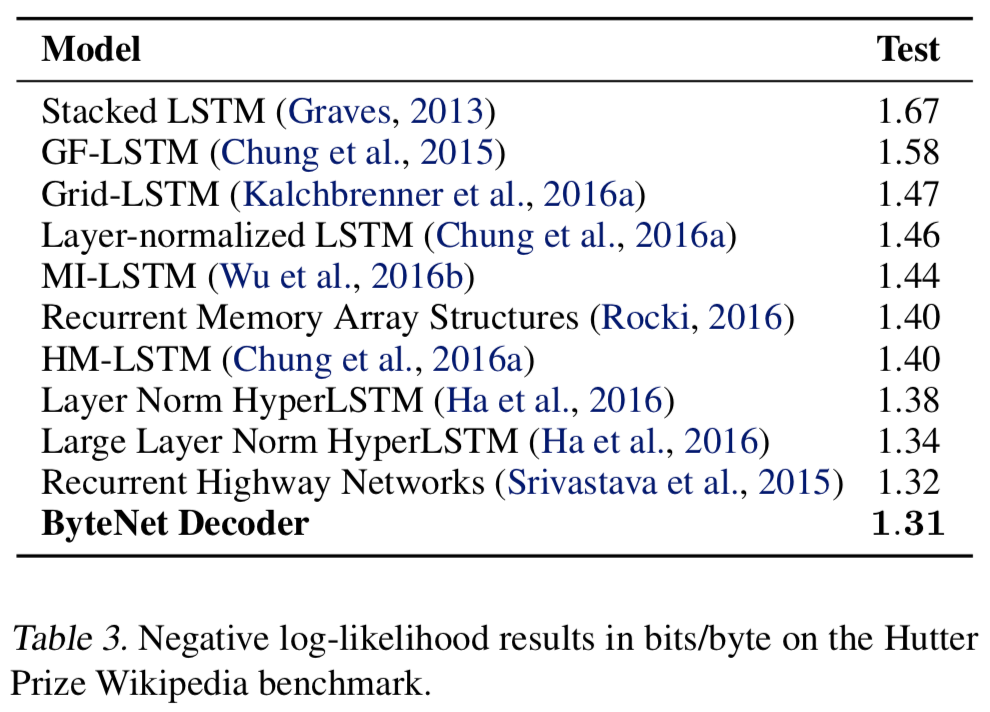 {: height=”50%” width=”50%”}
{: height=”50%” width=”50%”}
6. Character-Level Machine Translation
WMT English to German translation Task에 대해서 평가함
Validation:
NewsTest 2013Testing:
NewsTest 2014,NewsTest 2015German character vocab size: 323
English character vocab size: 296
ByteNet’s hyper params & training process
- 30 residual Blocks: 6 sets * 5 blocks
- 5 blocks’s dillation rates: 1, 2, 4, 8 and 16
- 여기선 Residual blocks with ReLUs 사용
- hidden units d: 800
- kernel size in the source network: 3
- maksed kernel size in the target network: 3
- Optimizer: Adam
- lr: 0.0003
- 각 문장은 special characters로 패딩적용됨; 패딩의 20% 정도는 dynamic unfolding을 적용하기 위해 source sentence에 적용함
- 학습시 효율적인 배치처리를 위해 패딩된 길이에 맞게 bucketting 사용함
- Beam search 사용: beam of size 12
- 30 residual Blocks: 6 sets * 5 blocks
Table2와 Table4에 따르면 ByteNet이 Character-level과 subword-level NMT와 비교할때 성능이 제일 좋음
- 그러나 word-pieces를 사용하는 GNMT보다는 낮은데 word-pieces는 subword라고 생각안하고 word-level이라고 생각하는듯
 {: height=”50%” width=”50%”}
{: height=”50%” width=”50%”} {: height=”50%” width=”50%”}
{: height=”50%” width=”50%”}Table 5는 ByteNet의 English-German Translation 결과를 보여줌
recodering, trasliteration(단어 그대로 갖다 쓰는거)이 일어나는 특징이 있음
 {: height=”50%” width=”50%”}
{: height=”50%” width=”50%”}Figure 6는 gradient를 heatmap으로 시각화한건데, 단어는 단어를 구성하는 characters의 gradient를 합치고, 각 컬럼에 대해서 normalization한 것임
두가지 dependency를 표현함
- source와 output의 dependency
- target과 previous target input의 dependency도 보여줌
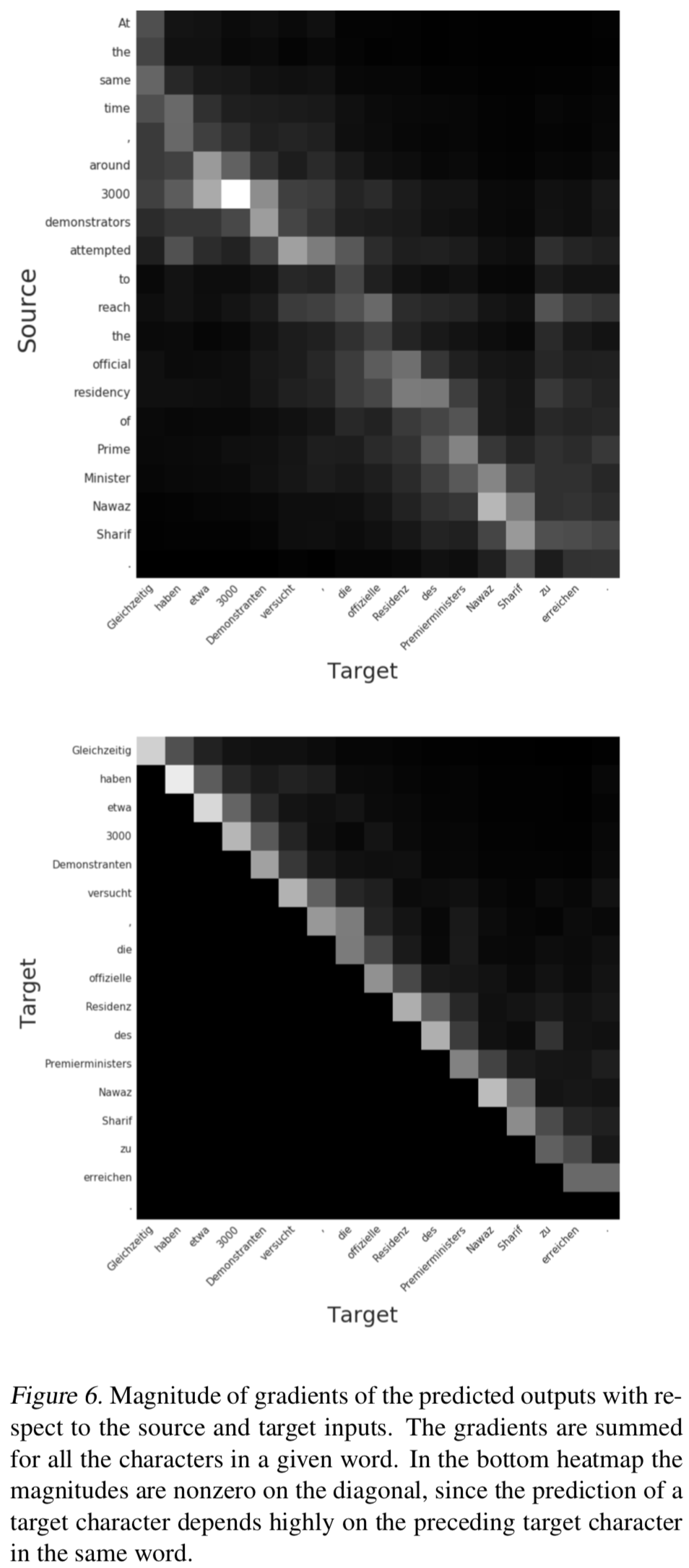 {: height=”50%” width=”50%”}
{: height=”50%” width=”50%”}
7. Conclusion
- linear running time 갖는 NMT 제안함
- RP 및 signal progation path 길이 줄이는 장점도 있음
- character-level language model에서 SOTA 찍고 RNN 이김
- character-to-character machine translation에서 SOTA 찍음
- 기대하던대로 tokens간의 alignment도 잘 나옴
Neural Machine Translation in Linear Time
https://eagle705.github.io/2019-04-12-Neural_Machine_Translation_in_Linear_Time/